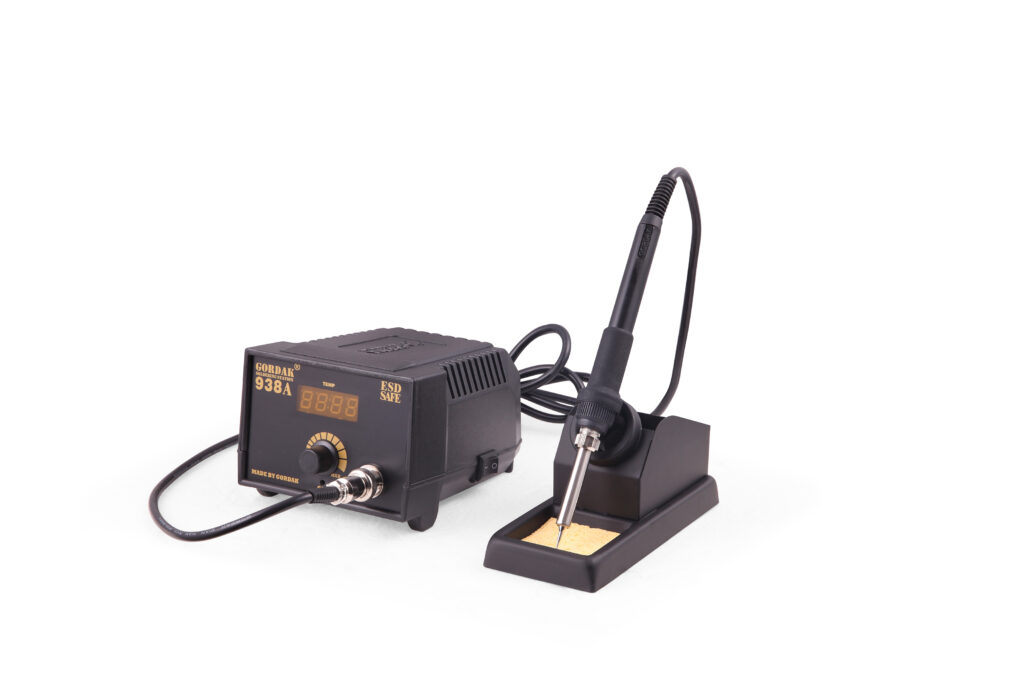Soldering is a fundamental skill in electronics, but it comes with risks that can be mitigated with proper safety precautions. Protecting yourself and your equipment is essential for maintaining a safe and productive work environment. Here are some key safety tips to keep in mind when soldering.

Personal Safety
- Wear Safety Glasses
- Protection: Solder can splash, and flux fumes can be irritating to the eyes. Safety glasses protect your eyes from potential hazards.
- Use a Well-Ventilated Area
- Fume Extraction: Soldering produces fumes that can be harmful if inhaled. Use a fume extractor or work in a well-ventilated area to minimize exposure.
- Ventilation: Ensure your workspace has adequate airflow to disperse fumes.
- Wear Protective Clothing
- Heat-Resistant Gloves: Protect your hands from burns with heat-resistant gloves.
- Long Sleeves: Wear long sleeves to protect your arms from accidental splashes of hot solder.
- Avoid Loose Clothing and Jewelry
- Safety Risk: Loose clothing and jewelry can catch on equipment or come into contact with hot soldering iron tips. Secure any loose items before starting.
- Be Mindful of Burns
- Hot Tools: Soldering irons and tips can reach very high temperatures. Always handle tools with care and never touch the tip of a hot soldering iron.
- First Aid: Have a first aid kit on hand to treat any minor burns immediately.
Equipment Safety
- Use Proper Soldering Iron Holders
- Prevent Accidents: Always place the soldering iron in a sturdy holder when not in use to prevent accidental burns or damage to your work surface.
- Check Your Equipment Regularly
- Inspect Cords: Regularly check power cords for wear and tear. Replace any damaged cords to prevent electrical hazards.
- Maintain Tips: Ensure soldering tips are clean and properly tinned for efficient heat transfer and to prevent oxidation.
- Use ESD-Safe Equipment
- Static Protection: Use ESD (Electrostatic Discharge) mats and wrist straps to protect sensitive electronic components from static electricity.
- Unplug When Not in Use
- Safety: Always unplug your soldering iron when it’s not in use to prevent accidental burns and reduce the risk of fire.
Workspace Safety
- Keep a Clean Workspace
- Organization: A cluttered workspace can lead to accidents. Keep your soldering area clean and organized.
- Disposal: Properly dispose of solder scraps and waste to avoid creating a mess or potential hazards.
- Have a Fire Extinguisher Nearby
- Fire Safety: Keep a fire extinguisher within reach and ensure you know how to use it in case of an emergency.
- Use Heat-Resistant Mats
- Surface Protection: Place heat-resistant mats on your work surface to protect it from accidental solder spills or the heat of the soldering iron.
Safe Soldering Practices
- Work at the Right Temperature
- Temperature Control: Use a soldering iron with adjustable temperature control to match the soldering requirements of your project. Too high a temperature can damage components, while too low can result in poor solder joints.
- Handle Solder and Flux Carefully
- Lead Safety: If using lead-based solder, wash your hands thoroughly after handling it to avoid lead poisoning.
- Flux Safety: Use flux in a well-ventilated area and avoid inhaling the fumes.
- Avoid Eating and Drinking
- Hygiene: Do not eat or drink while soldering to avoid ingesting harmful substances. Wash your hands thoroughly after soldering.
Electrical Safety
- Ground Your Equipment
- Static Discharge: Use grounded soldering stations to prevent static discharge, which can damage sensitive electronic components.
- Check for Electrical Safety Compliance
- Certifications: Ensure your soldering equipment meets safety standards and has necessary certifications, such as CE or UL markings.
- Be Aware of Your Surroundings
- Avoid Water: Keep soldering equipment away from water or moisture to prevent electrical hazards.
- Proper Lighting: Ensure your workspace is well-lit to avoid accidents and ensure precision in your work.
Emergency Preparedness
- Know Emergency Procedures
- Fire Safety: Familiarize yourself with the location and use of fire extinguishers, first aid kits, and emergency exits.
- First Aid Knowledge: Basic knowledge of first aid can be invaluable in case of minor burns or injuries.
- Plan for Power Outages
- Backup Plans: Have a plan for safely shutting down and securing your equipment in the event of a power outage.
Conclusion
Safety in soldering is paramount for protecting yourself, your equipment, and your work environment. By following these safety tips, you can minimize risks and ensure a safe and efficient soldering experience. Proper personal protective equipment, regular maintenance of tools, and a well-organized workspace are key to successful and safe soldering practices.
For more information on Gordak’s range of precision soldering tools and safety equipment, contact us at info@gordakelec.com.
Safety & Best Practices
Safety Tips for Soldering: Should You Wear Gloves?
Safety Tips for Soldering: Protecting Yourself and Your Equipment



